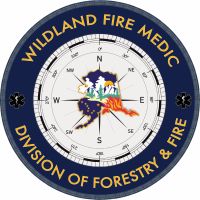
Mission Focused: Medical Care for Wildland Firefighters
The Division of Forestry & Fire Protection’s Fire Medic Program is dedicated to delivering critical emergency medical and occupational health support during wildfire suppression operations across Alaska’s expansive and remote landscapes. Our mission is to provide exceptional medical care in resource-limited and austere environments, ensuring the safety, health, and well-being of everyone involved in fire suppression, fuels reduction projects, and incident management efforts.
Wildland Fire Medics: Where Skill Meets Adventure
Wildland Fire Medics work directly on the fireline in remote and challenging wilderness environments across Alaska.
These highly trained professionals lead or assist in evacuations of sick or injured individuals, provide critical medical
care with limited resources, and often serve as the only medical provider on-site
Fire Medics commit to 14–21 day wildfire deployments, delivering emergency care on active fires, divisions, or other incident
assignments under the direction of Incident Commanders, Medical Unit Leaders, or Division Supervisors.
To meet the physical and mental demands of the role, candidates must pass an arduous physical fitness assessment.
Duties include hiking, camping, and performing physically demanding tasks in extreme and remote conditions.
Fire Medics travel by small aircraft, helicopters, boats, ATV/UTVs, pickup trucks, or on foot to reach assignments or patients as needed.
Be part of Alaska’s wildland firefighting efforts, where every decision and action makes a difference.

On the Frontlines: Single Resource Medical Providers (Fire Medics)
Our agency-sponsored single resources consist of Alaska-certified EMT Basics, Advanced EMTs, and Paramedics who are highly skilled medical professionals. They seamlessly integrate into fire suppression efforts across Alaska’s remote and resource-limited environments. Equipped with state-of-the-art gear, specialized modules, and evidence-based protocols, they are uniquely prepared to meet the challenges of wilderness medicine. These single resources are seasonal employees of the Division of Forestry & Fire Protection, not contractors. As valued team members, they benefit from career development opportunities provided by the division, including access to NWCG qualifications and pathways for professional growth within the organization and the broader wildland fire community.
Join the Frontlines: Become a Seasonal Fire Medic
- Recruitment Period: January–April prior to the start of the fire season.
- Must have wildland fire experience or applicable experience in military, remote medicine, or sufficient 911 experience as a provider.
- Must be 21 years or older.
- Must possess a valid Driver’s License.
- Must not have a disqualifying criminal record for employment or state certification.
- Current State of Alaska EMS certification at applicable certification level.
- Attend and successfully complete the Annual Austere Medical Academy held in the early spring typically late April to May.
- Complete or have completed applicable ICS & NIMS courses.
- Complete all required initial or refresher wildland firefighter courses.
- Maintain any applicable BLS and ALS credentials required for the current certification level.
- Physically fit and capable of passing an arduous WCPT test (pack test)
- Success as a Fire Medic requires exceptional teamwork, with the ability to collaborate seamlessly with diverse teams in high-pressure, unpredictable environments to ensure the safety and efficiency of wildfire operations.
The Skills You Need to Succeed
Alaska Wildland EMS Protocols - Acid Remap
Reach Out to the Fire Medic Team
Fire Medic Program Coordinator- David Calvert (david.calvert@alaska.gov)
Medical Director- Dr. Joseph Livengood (joseph.livengood@alaska.gov)
